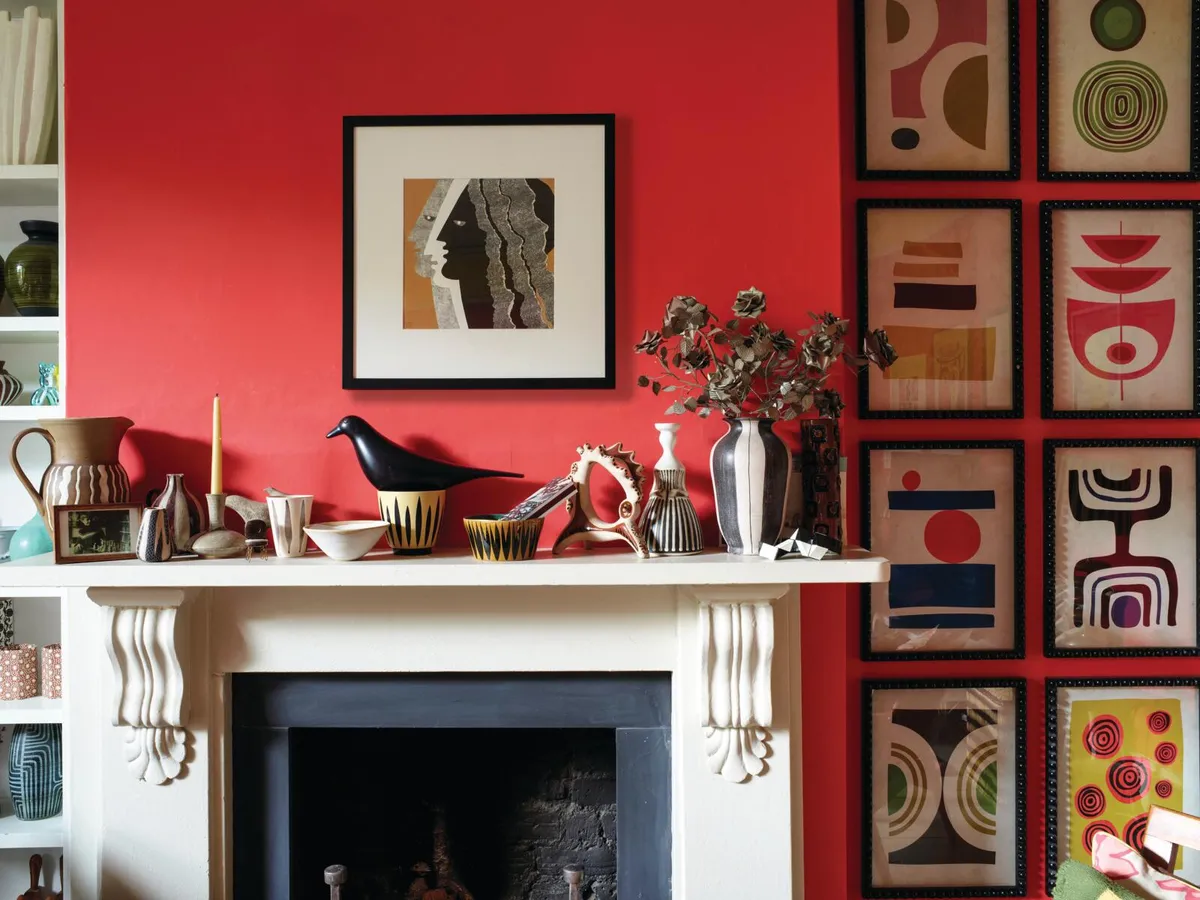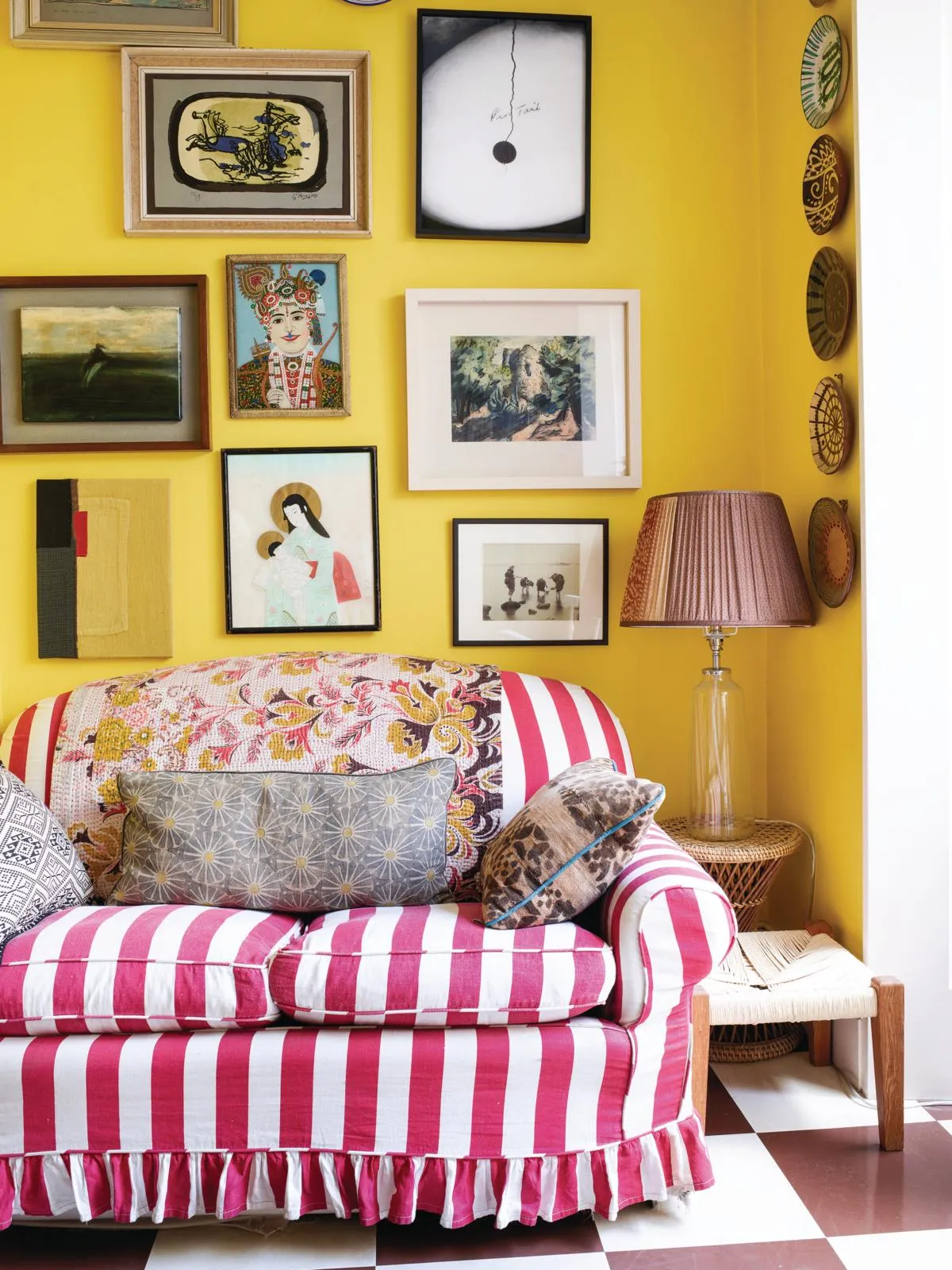When Lucinda Chambers says ‘nothing makes me happier than a decorating project’ she really means it. For the former Vogue fashion director, and founder of fashion label Colville and online shopping platform Collagerie, her home of almost three decades is a colourful, ‘organic’ collage of texture, pattern and colour.
It remains in a joyously, decorative ‘state of flux’, which both suits and reflects her inventive nature. ‘A house doesn’t have to be a homogenous whole; it’s much more interesting if it evolves gradually,’ Lucinda says.
And the evolution of her Victorian semi has also included ‘incremental, organic tweaks’ to the layout to suit the needs of her three sons: once outgrown, the white-walled playroom became a colourful sitting room; the glazed verandah was adopted as ‘the teenage smoking room’ and the decorative office-shed was built for her husband, Simon Crow, a tutor who specialises in ADHD.
The kitchen at the back, lit by a skylight, was an early addition. From the hallway, the view unfurls ‘like a country house’, drawing the eye through the French windows to the lawn. The lipstick-red Aga, the cushion-strewn window seat or the cocoa-and-cream chequerboard tiles haven’t dated.
Lucinda designed the extension herself – ‘I drew it up on aeroplanes,’ she says, ‘working out where the plugs would go and choosing the handles, so we wouldn’t waste the builder’s time.’
And that is the point of this house. ‘Nothing happens on a whim. I couldn’t afford that. There’s always a reason why I change things. It’s usually when things reach critical mass and the wallpaper is hanging in shreds. I turn it over in my mind and find inspiration from something – whether it’s a tile with beautiful colours or a piece of fabric – and I build out from there. Which is why there’s always something going on.’
You might also like a colourful London townhouse
Lucinda designed the latest addition – a set of porcelain blue shelves – to show off her collection of antique plates. Stacked in piles all over the kitchen floor, something had to change, she explains. ‘So I laid them and measured each one – and our brilliant joiner did the rest.’
Collections, of which there are many, always start with one chance find. ‘I’d never buy lots of the same thing at once. I prefer to build things up slowly.’ The group of framed vintage wallpapers in the sitting room began at a local market. ‘I spotted one and then I’d go every week to the same stall to see if the dealer had more.’ The frames are from Ikea, painted with chalk paints and distressed for an antique effect.
Paint plays a key role throughout the house: the dining room basks in an acid yellow, while the hallway, once deep pink, now resembles a ‘German urinal’ – in the most tasteful way, of course.
‘I drove our lovely painter mad by dividing the hallway up, and choosing a restful colour, Farrow & Ball’s Mizzle, for the top half and a shiny, conker brown from Paint & Paper Library.’ A dividing line in black accentuates the curve of the stairway.
It’s not always easy to get colour right, she admits, adding that decorating the bathroom involved painting hundreds of swatches onto the walls. ‘It looked like a rather fabulous patchwork, so it stayed for a while.’
It was this sort of resourcefulness that led to her career in publishing. As a student at Hornsey College of Art in London she taught herself to make jewellery, selling pieces at Camden Market to fund studies. When she spotted a pair of her earrings on a model in a magazine it was a revelation, she says.
You might also like a timeless renovation of a London Victorian home
‘I became determined to find out about the process of how magazines are put together.’ Since then she has overseen an estimated 4,000 shoots during her 36-year tenure at Vogue. She worked alongside photographers such as Mario Testino, Herb Ritts, and Josh Olins with whom she shot the Duchess of Cambridge for the 2016 cover.
Set-building, which she likens to ‘envisaging worlds from scratch’, was an important part of the job and sharpened her eye for scale and colour. Her greatest influence, however, was her mother.
‘Until I was 18, we moved every year. My mother was very entrepreneurial. She’d buy derelict properties and do them up around our ears. Then she’d sell them. The properties were always in Knightsbridge, page 58 of the A-Z and within walking distance of Harrods,’ says Lucinda, in a line that might have come from a pre-war novel.
‘Each one had a different style. It might be smoky glass and chrome furniture and low leather sofas for a mews house. The next was hessian wallpaper and rococo furniture. My mother was always experimenting.’
Which prompts the question: would she ever move herself? ‘Perhaps. But it would have to be somewhere very different.’ In the meantime, there is work to do here. A bedroom ‘beyond redemption’ is primed for a new look. ‘I’m envisaging sludgy, dirty pinks and tobacco tones. That’s what fascinates me: transformation.’
More homes from Homes & Antiques
- A colourful 1970s house in London
- A 1930s home filled with colour and pattern
- A converted Victorian pub in Shoreditch
- Kentaro Poteliakhoff's joyful Victorian home in Hackney
Sign up to ourweekly newsletterto enjoy more H&A content delivered to your inbox.














